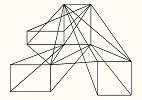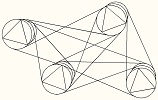


 |
 |  |
Physicists claim to have measured gravity waves twice in recent months. The source of the waves was said to be two black holes colliding 1.3 and 3 billion light years away. Physicists would have no ability to determine where black holes were colliding, even if the resulting vibrations of a mirror were real. Supposedly, a one second pulse of about ten sine waves occurred as motion of the mass of a mirror. The claims made with gravity wave measurements go beyond the limits of technology by factors of millions and billions. Motion was said to be detected down to 0.1 atto meters. That's 100 million times smaller than the vibration of atoms. It's a noise to signal ratio of 100 million to one. A laser beam was bounced off a mirror to see how much it moved. The wavelength of the laser was one micron, while the mirror supposedly moved 0.1 atto meter. That's a ratio of 10 trillion to one. It means the wavelength of the laser showed an apparent offset by a factor of one ten trillionth, which would have caused the light on a photodetector to change by a factor of one ten trillionths. Waves and photodetectors are not that precise by a long ways. When photodetectors are solid state, they produce noise in the parts per thousand range. When they are vacuum tubes, the noise is in parts per million range. At one part per million noise, a change of one ten trillionths would be 10 million to one noise to signal ratio. Physicists do not have a magical way of removing noise from technology. With careful manufacturing, noise can be reduced by about a factor of ten over commercial grade technology. It means the best possible technology misses the claims by factors of millions. But it isn't just quantities which were absurd in the claims. To counter vibrations, the detecting mass (mirror) was moved relative to the earth to hold it still. Control of motion was said to go down to 0.1 pico meter. An iron atom is 2,870 times larger than that (287 pico meters diameter). Obviously, mechanical devices are not that sensitive, as they require a lot of free space (slop) at every joint for adapting to temperature effects. So the claim was that inductive force was used in a manner similar to speaker motion. The problem is, such inductive force-controlled motion does not produce a definable position. It's like pulling on a spring. The opposing forces of friction and inertia produce uncontrolled and sporadic motion. To control motion, there must be feedback, which requires measurement of the problem. There is no way to measure the problem at such a minute level. Accelerometers detect movement of mass. Mass does not move at 2,870 times below the size of an iron atom. Hypothetically, feedback might look at the end-point measurement. But doing that would remove the signal. The control over motion was said to be adjusted at 16,384 times per second, while the signal supposedly produced several sign waves over one second of time. It means the adjustments would have removed the signal. To show the stupidity of physicists, a path length of 4 kilometers was used for the laser beam. Physicists say in their presentation at LIGO that the long path length takes longer for the light to get back, which gives them more time in the measurement. The measurement was not based on time. It was based on a micro distance variation of 0.1 atto meters. A better path length would have been a meter or two. There was a lot of expense in creating the most perfect vacuum possible in a tube 4 km long. In other words, the whole concept was contrived out of word salad with no relationship to laws of physics or technological limitations. When I sent criticism to several physicists at the universities, the only result was to remove most of the detailed description on the LIGO web site. I never got a response. The web site for the project, called LIGO, is here: https://www.ligo.caltech.edu/page/vibration-isolation.
|
|||||||||
 |
 |
 | ||